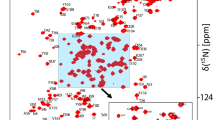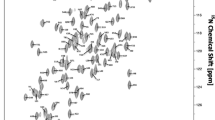Abstract
Staphylococcus aureus is a widespread and persistent pathogen of humans and livestock. The bacterium expresses a wide variety of virulence proteins, many of which serve to disrupt the host’s innate immune system from recognizing and clearing bacteria with optimal efficiency. The extracellular adherence protein (Eap) is a multidomain protein that participates in various protein–protein interactions that inhibit the innate immune response, including both the complement system (Woehl et al in J Immunol 193:6161–6171, 2014) and Neutrophil Serine Proteases (NSPs) (Stapels et al in Proc Natl Acad Sci USA 111:13187–13192, 2014). The third domain of Eap, Eap3, is an ~ 11 kDa protein that was recently shown to bind complement component C4b (Woehl et al in Protein Sci 26:1595–1608, 2017) and therefore play an essential role in inhibiting the classical and lectin pathways of complement (Woehl et al in J Immunol 193:6161–6171, 2014). Since structural characterization of Eap3 is still incomplete, we acquired a series of 2D and 3D NMR spectra of Eap3 in solution. Here we report the backbone and side-chain 1H, 15N, and 13C resonance assignments of Eap3 and its predicted secondary structure via the TALOS-N server. The assignment data have been deposited in the BMRB data bank under accession number 27087.


Similar content being viewed by others
References
Amulic B, Cazalet C, Hayes GL, Metzler KD, Zychlinsky A (2012) Neutrophil function: from mechanisms to disease. Annu Rev Immunol 30:459–489
Archer GL (1998) Staphylococcus aureus: a well-armed pathogen. Clin Infect Dis 26:1179–1181
de Jong NWM, Ramyar KX, Guerra FE, Nijland R, Fevre C, Voyich JM, McCarthy AJ, Garcia BL, van Kessel KPM, van Strijp JAG, Geisbrecht BV, Haas PJA (2017) Immune evasion by a staphylococcal inhibitor of myeloperoxidase. Proc Natl Acad Sci USA 35:9439–9444
Delaglio F, Grzesiek S, Vuister GW, Zhu G, Pfeifer J, Bax A (1995) NMRPipe: a multidimensional spectral processing system based on UNIX pipes. J Biomol NMR 6:277–293
Garcia BL, Zwarthoff SA, Rooijakkers SHM, Geisbrecht BV (2016) Novel evasion mechanisms of the classical complement pathway. J Immunol 197:2051–2060
Geisbrecht BV, Hamaoka BY, Perman B, Zemla A, Leahy DJ (2005) The crystal structures of EAP domains from Staphylococcus aureus reveal an unexpected homology to bacterial superantigens. J Biol Chem 280:17243–17250
Geisbrecht BV, Bouyan S, Pop M (2006) An optimized system for expression and purification of secreted bacterial proteins. Protein Expr Purif 46:23–32
Keller R (2004) The computer aided resonance assignment tutorial ISBN 3-85600-112-3
Kim HK, Thammavongsa V, Schneewind O, Missiakas D (2012) Recurrent infections and immune evasion strategies of Staphylococcus aureus. Curr Opin Microbiol 15:92–99
Lambris JD, Ricklin D, Geisbrecht BV (2008) Complement evasion by human pathogens. Nat Rev Microbiol 6:132–142
Lowy FD (1998) Staphylococcus aureus infections. N Engl J Med 339:520–532
Nauseef WM (2007) How human neutrophils kills and degrade microbes: an integrated view. Immunol Rev 219:88–102
Nauseef WM (2014) Myeloperoxidase in human neutrophil host defense. Cell Microbiol 16:1146–1155
Ricklin D, Lambris JD (2013) Compement in immune and inflammatory disorders: pathophysiological mechanisms. J Immunol 190:3831–3838
Ricklin D, Hajishengallis G, Yang K, Lambris JD (2010) Complement: a key system for immune surveillance and homeostasis. Nat Immunol 11:785–797
Shen Y, Bax A (2013) Protein backbone and sidechain torsion angles predicted from NMR chemical shifts using artificial neural networks. J Biomol NMR 56:227–241
Spaan AN, Surewaard BGJ, Nijland R, van Strijp JAG (2013) Neutrophils versus Staphylococcus aureus: a biological tug of war. Annu Rev Microbiol 67:629–650
Stapels DA, Ramyar KX, Bischoff M, von Köckritz-Blickwede M, Milder FJ, Ruyken M, Eisenbeis J, McWhorter WJ, Herrmann M, van Kessel KP, Geisbrecht BV, Rooijakkers SH (2014) Staphylococcus aureus secretes a unique class of neutrophil serine protease inhibitors. Proc Natl Acad Sci USA 111:13187–13192
Whitehead B, Craven CJ, Waltho JP (1997) Double and triple resonance NMR methods for protein assignment. In Reid DG (ed) Protein NMR techniques. Methods in molecular biology, vol 60. Humana Press, Totowa
Woehl JL, Stapels DAC, Garcia BL, Ramyar KX, Keightley A, Ruyken M, Syriga M, Sfyroera G, Weber AB, Zolkiewski M, Ricklin D, Lambris JD, Rooijakkers SHM, Geisbrecht BV (2014) The extracellular adherence protein from Staphylococcus aureus inhibits the classical and lectin pathways of complement by blocking formation of the C3 pro-convertase. J Immunol 193:6161–6171
Woehl JL, Takahashi D, Herrera AI, Geisbrecht BV, Prakash O (2016) 1H, 15N, and 13C resonance assignments of Staphylococcus aureus extracellular adherence protein domain 4. Biomol NMR Assign 10:301–305
Woehl JL, Ramyar KX, Katz BB, Walker JK, Geisbrecht BV (2017) The structural basis for inhibition of the classical and lectin complement pathways by S. aureus extracellular adherence protein. Protein Sci 26:1595–1608
Acknowledgements
This research was funded by awards from the National Institutes of Health to B.V.G. (GM121511 and AI111203). We are thankful to Dr. Justin Douglas of University of Kansas for helping with NMR spectroscopy. We also thank Center of Biomedical Research Excellence in Protein Structure and Function (COBRE-PSF) at The University of Kansas (NIH Grant P30 GM110761) for support in NMR studies.
Author information
Authors and Affiliations
Corresponding author
Ethics declarations
Conflict of interest
The authors declare no conflicts of interest.
Rights and permissions
About this article
Cite this article
Herrera, A.I., Ploscariu, N.T., Geisbrecht, B.V. et al. 1H, 15N, and 13C resonance assignments of the third domain from the S. aureus innate immune evasion protein Eap. Biomol NMR Assign 12, 175–178 (2018). https://doi.org/10.1007/s12104-018-9804-9
Received:
Accepted:
Published:
Issue Date:
DOI: https://doi.org/10.1007/s12104-018-9804-9




